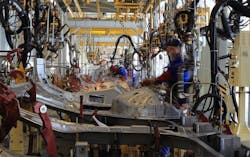2024 Recession Presents Fluid Power Industry Opportunities for Investment
After months of predictions about a potential recession in 2024 for the fluid power industry, and broader U.S. and global economies, the data shows this will in fact be the case.
The data indicates total shipments for fluid power products have tentatively peaked and are facing decline in the year ahead, said Patrick Luce of ITR Economics during the National Fluid Power Association’s (NFPA) Fall 2023 Economic Update webinar. He noted there are some headwinds in place which have the potential to cause downside pressures to linger into early 2025.
Declining profits, stricter lending criteria and overall elevated interest rates are creating tougher financial conditions for businesses. Because of this economic evidence, Luce said ITR expects contraction in a wide array of fluid power end markets. The current expectation is a nearly 10.9% contraction in 2024 compared to 2023.
However, those in the hydraulics and pneumatics industry should think of 2024 as an opportunity year he said. Companies should invest in their business to not only get ready for the nearly 10% year-over-year growth expected in 2025 but also take advantage of the reductions in pricing that will occur in 2024. A mild decline is expected for the producer price index throughout the year, offering good buy-low opportunities.
In addition, a light dip is expected for the interest rate environment in late 2024 and early 2025 which will benefit both the overall economy and businesses looking to make capital investments.
Hydraulic and Pneumatic Shipments to Decline in 2024
Both segments of the fluid power industry are expected to experience a downward trajectory in 2024 before seeing growth again in 2025. Looking at the broader forces within the industry, the data trends move in sync with one another, said Luce. The cyclical momentum hydraulics and pneumatics have experienced since 2020 is beginning to wain and a dip in overall activity is starting. This dip will continue into late 2024 and early 2025 at a variety of paces.
ITR is forecasting hydraulic shipments in 2023 to be up 6.3% compared to 2022 but down about 11% in 2024 before rebounding in 2025 when growth is currently forecast to be up 9.1%. Key end markets for this segment of the industry – including agriculture, mining and construction equipment – are facing downside pressures due to the tougher financial conditions these sectors, like many others, are experiencing, said Luce.
Softening in the overall economy is presenting headwinds for the agricultural and mining equipment markets, both of which are already declining, although he noted the oil and gas segment is an outlier. This portion of the mining industry is showing some resilience and rising at a steady pace. It is expected to only experience a mild decline in 2024 and therefore could be an area of opportunity for hydraulics manufacturers.
Pneumatics shipments should end 2023 up about 5.3% compared to 2022 based on recently revised data from ITR, said Luce. In 2024, this segment of the fluid power industry is expected to be down 5.9% compared to 2023 but rebound to growth of 2.9% in 2025.
Early to mid-2024 is when the pullback in pneumatic shipments is primarily expected, he said. This is due in part to declines in the manufacturing sector – a key customer market for pneumatic components and systems.
READ MORE: Growth Potential Ahead for Hydraulic Fittings Market
Focus on Positive Markets for Fluid Power
Given the forecasted slower growth trends, it will be important for companies working in the fluid power space to strategize into the market winners in 2024, said Luce.
He said companies should be planning now and have contingency plans in place for both upside and downside risks which could occur in 2024. Some of the leading indicators show an economic recovery could happen sooner, presenting a possible upside risk for which businesses will want to be prepared. Potential downside risks to account for include waning profitability and higher interest rates.
While planning for 2024 and beyond, he said companies should think about previous economic booms and what they wish they had done differently during the downturn to set their business up for success. Using this information can help better time actions to take so a business can capitalize on and be ready for the rise in economic conditions anticipated in 2025 and much of the second half of the decade.
Companies should look for ways to lean into their competitive advantages while also taking the time to address any possible competitive disadvantages in their marketplace. Identify, recognize and address them, said Luce. The slower economy provides an opportunity to invest in system upgrades and efficiency improvements. Anything a company can do now to abate current labor challenges will better set it up for success during the last half of the decade.
Manufacturing Production Offers Insights into Opportunity Areas
The U.S. Total Manufacturing Production Index has been in decline through much of 2023 and expected to remain so into 2024. However, it will already be in a state of recovery by the end of 2024 and into 2025. Luce explained that ITR does not define recovery as a market experiencing growth but instead as the rates of change becoming less negative.
By year-end 2024, manufacturing production rates of change will be getting less negative, he said, and gearing up for growth in 2025.
Besides looking at this broader macroeconomic trend, he said examining where manufacturing output is most robust is beneficial as well by targeting regionally specific opportunities. The best way to ride out a recession is to gain market share, whether in vertical markets or exploring new ones.
As manufacturing production enters recovery, there may be market regions – like the Midwest – where that sector plays a greater role in overall GDP and therefore could be an opportunity area to explore.
Related to this, Luce said there is a lot of new money coming into the U.S. to propel new spending in the economy for more production due to reshoring efforts as well as foreign direct investment. Monitoring these activities could provide fluid power manufacturers with potential new business opportunities. Investments in electrification, including battery production, and chemicals are strong sectors from a reshoring standpoint.
Fluid power companies should also re-evaluate their product offerings and end markets. It is important to place an emphasis on the products and services which tend to do well during periods of contraction, said Luce. These typically include those capable of improving a customer’s return on investment. As such, a company’s marketing and other aspects should be focused on how they can offer a competitive advantage in this area.
What is a recession?
Patrick Luce of ITR Economics said there are two ways to define a recession. The first is the technical definition which is when there are two consecutive quarters of GDP (gross domestic product) decline.
He said ITR is not forecasting there to be two consecutive quarters of GDP decline in 2024. Instead, it will be a little bouncy – so quarter one down, quarter two up, quarter three down and quarter four up – and have a generally flat trend. Ultimately, GDP will not enter into a technical definition of a recession.
The more formalized definition from the National Bureau of Economic Research says a recession occurs when there are decreases in overall employment and overall output and industrial production. Luce said ITR does see recession in these terms occurring in 2024, and it has already begun.
He said now is also the time to evaluate any unprofitable business segments. If there are ones which are having trouble making profits in 2023, they will likely have more trouble doing so in 2024 and therefore a company should de-emphasize investments in these segments. Reallocate time and investment into more profitable market segments to help maintain overall business health.
Potential in Maintenance Services
According to Luce, services have been holding up better than the overall economy and spending on durable goods. The rates of change for U.S. Commercial and Industrial Equipment Repair and Maintenance Services Revenue remain elevated.
As such, this an area the fluid power industry could evaluate as a potential avenue for new revenue streams either by providing services or offering solutions for those in the service industry. The service and repair space is not necessarily recession proof but recession resilient, said Luce, and therefore an area of opportunity during these economic periods.
The rates of change look to remain elevated in the foreseeable future for this space, making it one for those in the hydraulics and pneumatics industry to consider while making marketing and strategy plans for the coming year.
How Broader Macroeconomic Trends Could Impact Hydraulics and Pneumatics
There are several trends happening in the broader macroeconomy which could influence the fluid power industry and its customer markets in the coming year.
Third quarter 2023 U.S. GDP (gross domestic product) figures were generally positive, said Luce, and slightly above expectations. The U.S. economy grew during the quarter and record high levels were achieved for real GDP.
However, he said there are some cracks showing in the economy’s general trends. Consumers continued to spend in the third quarter, but delinquency rates are starting to rise, an indication financial weakness is beginning for consumers.
The ability of consumers and businesses to weather the higher interest rate environment may be dwindling as indicated by the supply of money in the economy drying up and weakening credit conditions. The latter could make it more difficult to get loans and is a key factor for the recessionary headwinds ITR sees, said Luce.
How the Federal Reserve interprets the third quarter GDP figures could determine when the economic recovery begins, said Luce. The Federal Reserve could see the strong performance as a reason to keep interest rates at higher levels for a longer period of time which could delay the start of the 2025 rebound.
When digging deeper into what drove third quarter GDP growth, he said personal consumption expenditures for household services was the number one driver. Utilities are included in this and take away from spending on other activities, especially durable goods. The pace of growth for goods was smaller and most resided in the automotive sector, he said, which is not expected to be as robust going forward because much of the pent-up demand and supply chain pressures from the last few years are abating.
Government spending – at local, state and federal levels – was also a strong contributor to GDP growth in the third quarter. Luce said this could be an opportunity area for the fluid power industry. All levels of government are still spending money as well as adding staff, making it one of the stronger market sectors currently. The Infrastructure Bill, CHIPS and Science Act and Inflation Reduction Act are all helping put money into the economy and providing good opportunities for domestic production with a lot of reshoring activities occurring as a result.
Watch our interview with Eric Alstrom, president of Danfoss Power Solutions, to hear how he believes the Infrastructure Bill will benefit the fluid power industry.
Take Precaution with Inventory Levels
One GDP growth factor which particularly stood out to Luce – and was the second largest contributing factor to third quarter growth – was the fact increases in non-farm inventories were very elevated. Increases in inventory can add to the overall GDP level but are not necessarily a signal of economic health, he explained. Companies which have rapid rises in their inventories must typically pull back on business investment so they can rebalance their inventories.
Inventories are likely going to pose challenges for the economy going forward and many companies are already feeling the effects of the current imbalance as demonstrated by business investments currently being down from year-ago levels.
Luce said a key trend to monitor is inventory levels and that it is normal for the U.S. economy to overbuild inventories when transitioning from growth to contraction. This happens because the inventory turnover ratio falls and companies want to compensate, which is a normal cyclical relationship.
However, the COVID-19 pandemic exacerbated this because of the challenges many businesses were facing. There was an elevated lead time situation due to global supply chain pressures compounded by a surge of stimulus spending and demand, he said. This created a lot of upside pressure on lead times, causing businesses to buy forward on their inventory to keep up.
As supply chain pressure and demand began to slow, there has been a surge of inventory throughout the last half of 2022 and into 2023. Over the next 12 months ITR expects a rebalancing of inventories. Businesses will sell off their existing inventories and not necessarily build them up or grow them, said Luce.
This could provide opportunities for those in the fluid power industry. As businesses look to offload their inventories, hydraulics and pneumatics manufacturers could take advantage by locking in contracts and stocking up their own inventories in the later half of the year in preparation for the growth anticipated in 2025. Typically, he said the economy lags in inventory planning, but this could be a chance for fluid power manufacturers to plan ahead and have the capacity to meet demand as it picks up again after 2024.
Ken Baker, CEO of Bailey International, said in an interview with Power & Motion the company will be keeping a close eye on its inventory levels because it is important to find a good balance between not building up too much but being ready for the coming rebound.
Watch our interview with Ken Baker to hear how views the hydraulics market performing in 2024 and how the company will be preparing for future growth.
Key Economic Takeaways for the Fluid Power Industry
Although 2024 will be a recessionary year, it is expected to be a mild one – and nothing like what was experienced in 2008. The slowdown in economic activity will provide an opportunity for many businesses to breathe after the strong uptick which took place as the world emerged from the COVID-19 pandemic.
READ MORE: A “Good” Recession for Hydraulics and Pneumatics
With demand and the overall economy slowing, supply chain pressures have eased which is beneficial for many businesses as they spent much of the past few years trying to overcome this challenge. Current data indicates more normal supply chains are likely over the next 7 months.
Related to this, nearshoring and reshoring efforts are creating shorter supply chain networks that are both good for businesses as well as potential opportunity areas for many.
Luce said nationalism – bringing more production back to the U.S. and nearby regions – is the long-term play that will benefit economic growth going forward. While the country is facing an aging demographic, it is not nearly as pressured as most advanced nations like China and Europe.
Interest rates and various geopolitical events could present challenges, and should continue to be monitored.
But in general, 2024 should be seen as a year to invest in one’s business and maximize competitive advantages to prepare for the growth anticipated in 2025 and beyond.
About the Author
Sara Jensen
Executive Editor, Power & Motion
Sara Jensen is executive editor of Power & Motion, directing expanded coverage into the modern fluid power space, as well as mechatronic and smart technologies. She has over 15 years of publishing experience. Prior to Power & Motion she spent 11 years with a trade publication for engineers of heavy-duty equipment, the last 3 of which were as the editor and brand lead. Over the course of her time in the B2B industry, Sara has gained an extensive knowledge of various heavy-duty equipment industries — including construction, agriculture, mining and on-road trucks —along with the systems and market trends which impact them such as fluid power and electronic motion control technologies.
You can follow Sara and Power & Motion via the following social media handles:
X (formerly Twitter): @TechnlgyEditor and @PowerMotionTech
LinkedIn: @SaraJensen and @Power&Motion
Facebook: @PowerMotionTech

Leaders relevant to this article:





